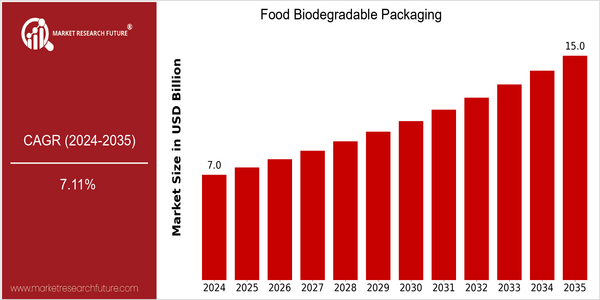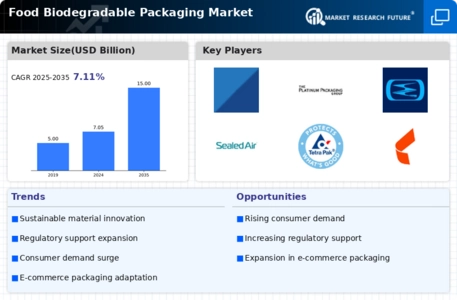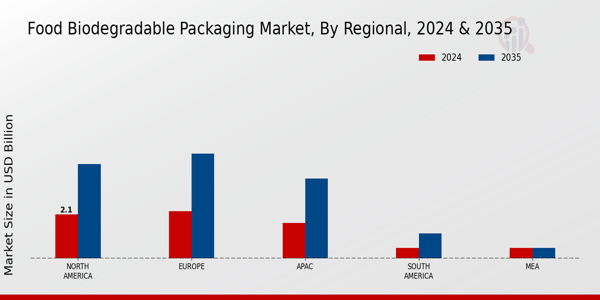Food Biodegradable Packaging Size
Market Size Snapshot
| Year | Value |
|---|---|
| 2024 | USD 7.05 Billion |
| 2035 | USD 15.0 Billion |
| CAGR (2025-2035) | 7.11 % |
Note – Market size depicts the revenue generated over the financial year
The world market for food biodegradable packaging is expected to grow from a value of $ 7.0 billion in 2024 to $ 15.0 billion by 2035. This growth translates into a strong CAGR of 7.11 percent between 2025 and 2035. The growing concern about the environment and the harmful effects of plastic waste on the environment are the main drivers for this market. Moreover, the growing demand for eco-friendly packaging solutions and the stricter regulatory framework are driving companies to invest more in biodegradable materials and related technology. Further growth is expected as a result of the technological developments in the field of bioplastics and the development of new materials that can decompose naturally. The industry's leading companies, such as BASF, Novamont and Tetra Pak, are actively involved in strategic initiatives, such as collaborations and new product launches, to enhance their biodegradable packaging offerings. Tetra Pak, for example, has introduced a range of sustainable packaging solutions based on renewable materials, while BASF has been at the forefront of developing new biopolymers. These initiatives not only meet the changing needs of consumers, but also position these companies as leaders in the transition towards a more sustainable packaging landscape.

Regional Market Size
Regional Deep Dive
The Food Biodegradable Packaging Market is growing significantly across the globe, owing to the growing awareness of the environment, the stricter regulations on the use of plastics, and the increasing demand for sustainable packaging solutions. Each region has its own characteristics, influenced by the preferences of consumers, the regulatory framework, and the economic conditions. North America and Europe lead the market in terms of innovation and adoption. The Asia-Pacific region is expected to expand at a rapid pace, owing to the growing demand from the emerging economies. The Middle East and Africa are slowly embracing biodegradable solutions, and Latin America is witnessing a growing trend toward sustainable packaging.
Europe
- The European Union's Green Deal aims to make Europe the first climate-neutral continent by 2050, which includes strict regulations on plastic waste, significantly boosting the demand for biodegradable packaging solutions.
- Innovative projects like the EU-funded BioPack project are developing new biodegradable materials from renewable resources, with participation from key players such as BASF and Tetra Pak, enhancing the market's growth potential.
Asia Pacific
- Countries like Japan and South Korea are leading the charge in biodegradable packaging innovations, with companies such as Mitsubishi Chemical and LG Chem investing heavily in research and development to create sustainable packaging solutions.
- The growing consumer awareness regarding environmental issues in countries like India and China is driving demand for biodegradable packaging, supported by government initiatives promoting sustainable practices.
Latin America
- Brazil is witnessing a surge in biodegradable packaging solutions, driven by local companies like Biopack and their efforts to replace traditional plastics with sustainable alternatives in the food sector.
- Government regulations in countries like Mexico are increasingly favoring biodegradable materials, with initiatives aimed at reducing plastic pollution, thus creating a favorable environment for market growth.
North America
- The U.S. has implemented several state-level bans on single-use plastics, prompting food manufacturers to seek biodegradable alternatives, with companies like Biopak and Eco-Products leading the charge in providing innovative packaging solutions.
- Recent advancements in biopolymer technology have enabled companies such as NatureWorks to produce high-performance biodegradable materials, which are increasingly being adopted by major food brands like Nestlé and Unilever.
Middle East And Africa
- The UAE has launched initiatives like the 'UAE Vision 2021' which emphasizes sustainability, leading to increased investments in biodegradable packaging solutions from companies like Bioware and EcoPack.
- South Africa is seeing a rise in local startups focusing on biodegradable packaging, such as The Biodegradable Company, which is responding to both consumer demand and regulatory pressures to reduce plastic waste.
Did You Know?
“Approximately 30% of all food packaging is made from plastic, and the shift to biodegradable alternatives could significantly reduce the environmental impact of food waste.” — Food and Agriculture Organization (FAO)
Segmental Market Size
The food biodegradable packaging market is an important part of the packaging market, which is currently experiencing a boom due to the rising demand for sustainable solutions. A number of factors are driving this demand, such as increased consumer awareness about the environment and the tightening of plastic waste regulations. The European Union’s single-use plastics directive, for example, aims to reduce the use of plastics and is thus a further incentive for the shift to biodegradable alternatives. Biodegradable food packaging is currently being introduced in a limited manner, with companies such as Biopak and TIPA leading the way with their innovative product offerings. In food service, the most important application areas are food containers and cutlery, and in particular fast-food chains are increasingly introducing biodegradable packaging to improve their sustainability profiles. The introduction of these products is also being accelerated by macro-economic trends such as the growing international focus on sustainable solutions and the pandemic of COV-19, which has changed the way people think and act. It is also the case that the biodegradable food packaging market is being driven by the development of new technologies, such as the compostable materials and the advanced bioplastics, which are enabling companies to meet both regulatory requirements and consumers’ expectations.
Future Outlook
OVERVIEW: The food biodegradable packaging market is set to grow at a strong CAGR of 7.11% between 2024 and 2035. This growth will be driven by a number of factors, including a rise in public awareness of the importance of sustainable development, the tightening of regulations on plastic waste, and advances in biodegradable materials. The share of biodegradable packaging in the food sector will rise substantially, potentially reaching 31% of the food packaging market by 2035. In the meantime, technological developments such as the development of new biopolymers and the development of improved production processes will further improve the performance and cost-effectiveness of biodegradable packaging. And the emergence of public policies and initiatives promoting sustainable development will accelerate their uptake. Also contributing to market growth will be the rise of e-commerce and the need for sustainable packaging in food delivery services. Business will respond to these developments by investing in sustainable alternatives to packaging, and the food biodegradable packaging market will become an important element in the transition to a circular economy.














Leave a Comment